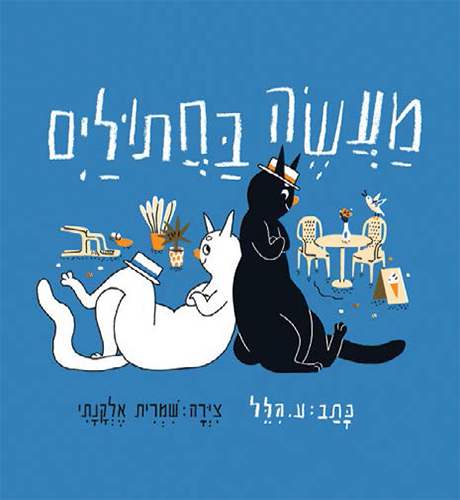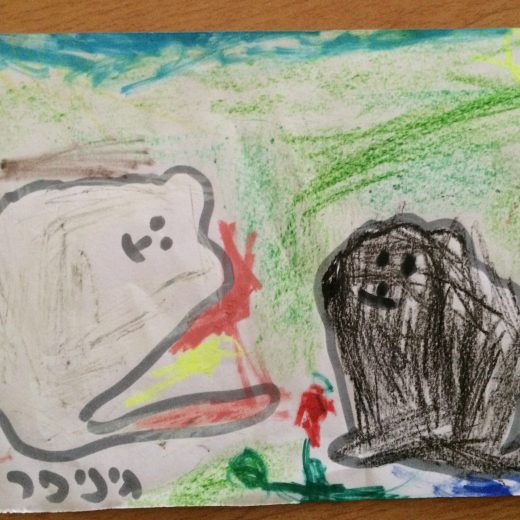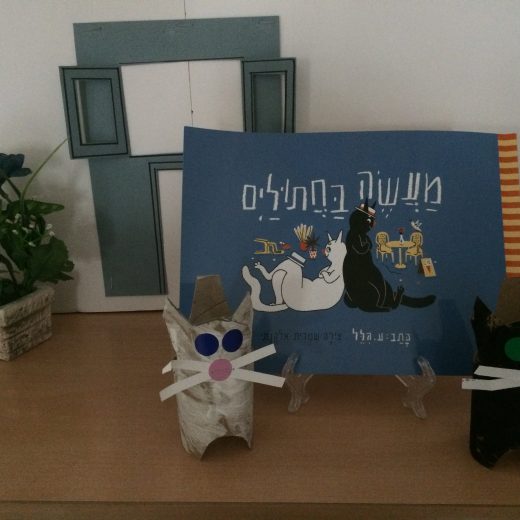מעשה בחתוליים
מאת: ע. הלל / איורים: שמרית אלקנתי
תרגום לרוסית של ההצעות להורים
"Баллада о котах": Аин Хилель
Иллюстрации: Шимрит Элканати
Может быть, черный "самый –пресамый красивый"? Может быть, белый "в сто раз умножить на сто красивее"? Нельзя изменить внешний вид, но черты характера можно исправить. Даже коты в стихотворении учатся мириться и жить в согласии друг с другом и с самим собой.
"Пусть честь твоего друга будет так же дорога тебе, как твоя собственная" (Пиркей Авот 2:13)
Два кота насмехаются друг над другом и расхваливают свой внешний вид. Они ведут себя заносчиво, и оба злятся и обижаются. Даже хорошие друзья иногда ссорятся и не всегда относятся друг к другу с уважением. Мишна "Пусть честь твоего друга будет так же дорога тебе, как твоя собственная" подчеркивает, что каждый человек должен уважать своего друга как себя самого. Нужно стараться не обижать друзей, а если мы все же злимся и обижаемся, то нужно помнить, что есть возможность помириться и продолжать жить мирно.
Занятия в кругу семьи
• Полистайте книжку и вместе рассмотрите прекрасные рисунки Шимрит Элканати. Так ли вы представляли себе героев стихотворения? Вы и ваши дети можете сами нарисовать двух котов и создать свою собственную семейную версию книжки.
• С помощью старых носков, тряпочек и пуговиц можно вместе сделать кукол, надеть их на руку и представить с их помощью рассказ – один раз своими словами, а второй раз – словами и рифмами стихотворения.
• Стихотворение "Баллада о котах" написано рифмами, которые легко декламировать. Дети могут постараться выучить его и прочитать его наизусть.
• Хотели ли вы когда-нибудь быть похожими на кого-нибудь другого? Возможно, вы мечтали, чтобы у вас были кудрявые волосы или волосы другого цвета, а может быть, вам очень хотелось быть выше или ниже ростом? Прочитав книжку, попробуйте нарядиться в маскарадный костюм и дайте себе почувствовать, как это выглядеть по-другому. После игры стоит подчеркнуть красоту и лучшие черты характера каждого члена семьи и поощрять детей радоваться тому, какие они есть.
• "Пусть честь твоего друга будет так же дорога тебе, как твоя собственная" – По следам книжки можно объяснить детям смысл Мишны и побеседовать о дружбе. Кто ваши друзья? Ссоритесь ли вы иногда? Как вы миритесь? Можно нарисовать две картинки: на одной два друга ссорятся, а на другой мирятся.
• Из-за обиды и злости у котов встает дыбом шерсть и поднимаются хвосты. Они не хотят говорить друг с другом...Можно поговорить с детьми о чувстве обиды. Как можно понять, что друг или член семьи обижен нами? Что нужно делать в этом случае? И как нужно реагировать, если кто-то обижает нас?
• Знакомы ли детям другие рассказы и стихи Аина Хиллеля? Стихотворение "Баллада о котах" было опубликовано в его сборнике стихов с иллюстрациями Алоны Френкель. Можно поискать эту книжку дома или в библиотеке, сравнить иллюстрации и получить удовольствие от чтения других стихотворений из этого сборника.
Об Аине Хиллеле
Аин Хиллель (Хиллель Амир) родился в киббуце Мишмар А-Эмек в 1926 году. Он был писателем, поэтом и ландшафтным архитектором. В своих стихах он часто описывал природу и животных. Поколения детей в Израиле росли на его произведениях, например, на рассказах о "Дядюшке Симхе" - рифмованных рассказах о необычном рассеяном герое. Эти рассказы были инсценированы и поставлены в театре. Его сборники стихов и рассказов для детей иллюстрировали лучшие израильские художники-иллюстраторы, среди них Шмуэль Кац, Рути Царфати и Алона Френкель. Аин Хиллель удостаивался многих призов и премий за свою работу. Он скончался в 1990 году.








